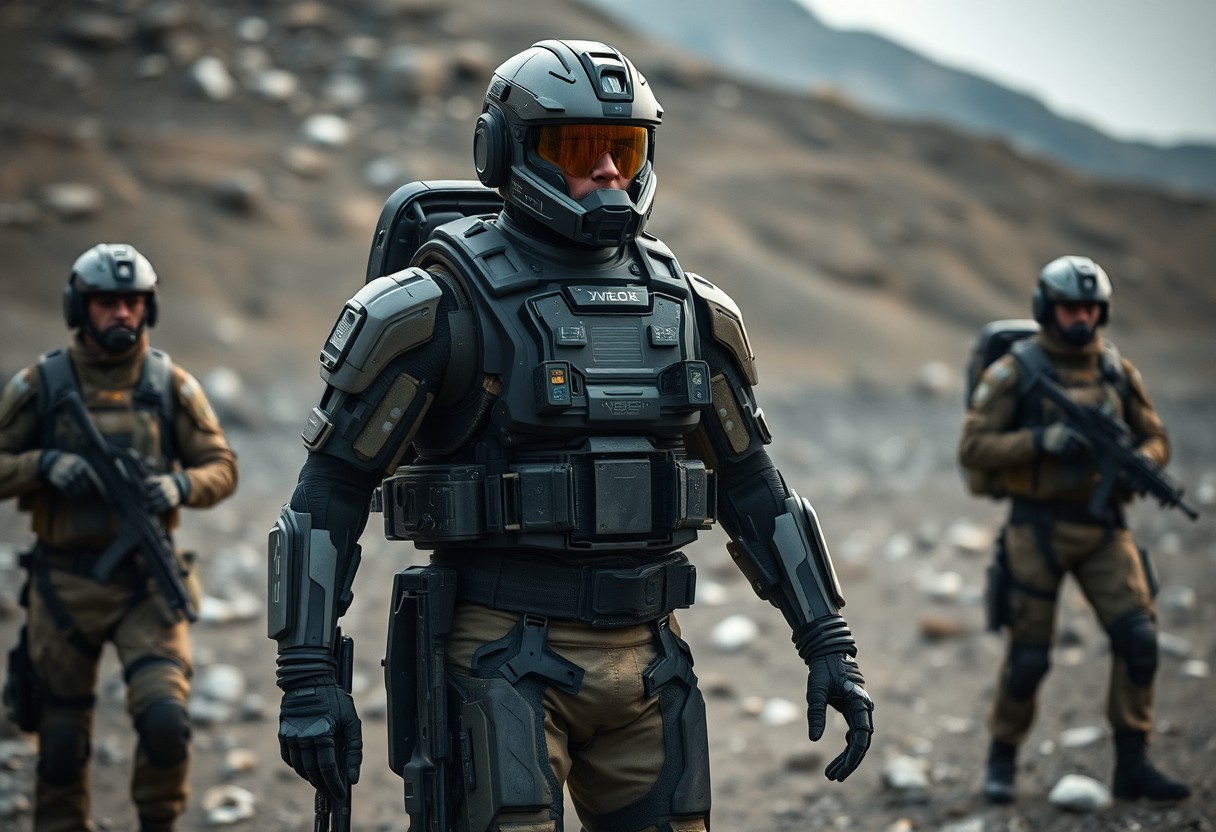Exoskeletons are revolutionizing the landscape of modern warfare, providing soldiers like you with enhanced strength, endurance, and protection in the field. Designed to augment your physical abilities, these sophisticated suits enable you to carry heavier loads, reduce the risk of injury, and improve overall mission effectiveness. In an era where rapid adaptability can mean the difference between mission success and failure, understanding the role of mechanized exoskeletons in enhancing infantry resilience is necessary for anyone involved in defense and military operations.
The Evolution of Exoskeleton Technology
While the concept of exoskeleton technology may seem futuristic, its roots trace back to the mid-20th century. Innovations in materials and engineering techniques over the decades have allowed for the development of increasingly sophisticated systems. As military needs evolved, so too did the designs and functionalities of these exoskeletons, ultimately leading to their application in various fields, including defense and rehabilitation.
Historical Advances
Among the early developments in exoskeleton technology were mechanized suits designed for industrial applications and medical rehabilitation. During the 1960s, the first functional exoskeleton, known as the “Hardiman,” was created for lifting heavy objects. This pioneer set the stage for future advancements, demonstrating the potential to enhance human strength and endurance.
Modern Developments
Behind today’s cutting-edge exoskeletons is a blend of advanced robotics, artificial intelligence, and lightweight materials. Modern systems are designed not only to augment physical capabilities but also to enhance situational awareness for military personnel. These innovations offer you improved mobility, reduced fatigue, and increased resilience in combat environments.
Plus, the latest exoskeletons are equipped with sensors that can analyze your movements and adapt in real-time, providing a seamless integration of technology and human capability. Enhanced battery life ensures that these systems remain operational for extended periods, catering to the demands of modern infantry. Collaborative efforts between military and industrial sectors continue to drive innovation, potentially transforming how you engage in and navigate combat scenarios, ultimately leading to a new era of infantry resilience.
Mechanized Exoskeletons in Military Applications
One of the most innovative developments in modern warfare is the use of mechanized exoskeletons, designed to augment soldiers’ physical capabilities and resilience on the battlefield. These advanced systems provide enhanced strength, endurance, and mobility, empowering infantry units to manage heavy loads more efficiently and reducing the risk of injury. As military technology continues to evolve, the integration of exoskeletons represents a significant leap towards creating a more effective and resilient fighting force.
Current Use in Infantry
For infantry units today, exoskeletons are being integrated into various tasks, including logistics, transportation of supplies, and direct combat scenarios. These systems not only facilitate the movement of heavy equipment but also allow soldiers to maintain peak performance over extended missions. Real-time demonstrations in training exercises showcase how exoskeletons can reduce fatigue, enabling soldiers to focus more on their strategic objectives rather than their physical constraints.
Future Potential and Innovations
Before the full capabilities of mechanized exoskeletons can be realized, ongoing research and development are crucial to address challenges such as power supply, weight management, and user interface. The potential for advanced features, such as AI integration for enhanced situational awareness or adaptive materials that adjust to the environment, could revolutionize infantry operations. Furthermore, collaboration between military agencies and tech firms will likely lead to rapid advancements, making the possibilities for future exoskeletons nearly limitless.
The integration of advanced technologies in exoskeletons is paving the way for significant improvements in infantry operations, from autonomous features that allow for collaborative movement on the battlefield to customizable systems that cater to individual soldier needs. As the design and engineering of these devices advance, you may find that the exoskeletons of tomorrow will not only enhance physical capabilities but will also provide optimized communication tools, improving coordination and decision-making in real-time scenarios. As these innovations unfold, expect to see a marked transformation in how soldiers approach and engage in combat, ultimately enhancing their resilience in various situations.
Enhancing Physical Capabilities
Clearly, mechanized exoskeletons are transforming the way soldiers engage in combat, providing significant enhancements in physical capabilities. These advanced suits allow you to carry heavier loads with ease and navigate challenging terrains, thus improving performance. According to an insightful analysis, The Exoskeleton Will Change Future Combat, the integration of exoskeleton technology holds immense promise for the future defense landscape.
Increased Strength and Endurance
Above all, exoskeletons amplify your natural abilities, enabling you to lift significantly more weight and sustain prolonged activity without succumbing to fatigue. By incorporating electric motors and smart materials, these suits boost your strength, allowing you to carry vital gear and equipment that would otherwise be unmanageable.
Reducing Injury Rates
About 70% of injuries in military settings stem from overexertion and repetitive movements. Exoskeletons reduce these risks by redistributing loads and minimizing strain on your body. This stabilization permits you to focus better on your mission while fostering a safer environment.
Injury rates are an ongoing concern for infantry personnel as the physical demands of military operations can lead to various musculoskeletal injuries. By utilizing exoskeleton technology, you can expect to experience a marked reduction in these risks, as the suits provide support to your joints and muscles during strenuous tasks. This not only aids in enhancing your performance but also ensures your longevity in the field, allowing you to serve more effectively over extended periods.
Psychological Impact on Soldiers
Unlike traditional combat gear, mechanized exoskeletons can significantly influence the psychological well-being of soldiers. By alleviating physical burdens and enhancing capabilities, these advanced systems help foster a more confident mindset in the field. This can lead to improved decision-making and reduced anxiety under pressure, enabling you to focus on your mission rather than fatigue or discomfort.
Confidence and Morale
To harness the benefits of mechanized exoskeletons, your confidence and morale can be greatly enhanced. When you feel physically empowered and capable, it translates into stronger team dynamics and a more resilient attitude towards challenges. The psychological boost from these enhancements can elevate your performance and contribute positively to your unit’s overall effectiveness.
Stress Reduction and Mental Health
On the battlefield, stress can be overwhelming, but mechanized exoskeletons offer support that aids in minimizing mental strain. By reducing the physical demands placed on you, these innovative tools can lessen the mental load, allowing you to better cope with high-pressure situations.
Even small reductions in stress can lead to substantial improvements in mental health. When you’re not as fatigued or burdened by heavy equipment, the likelihood of burnout and anxiety diminishes. By facilitating easier movement and lessening physical strains, exoskeletons promote better coping strategies, helping you maintain a sharper focus and a more positive outlook during and after deployments. This enhanced mental state can lead to improved problem-solving skills and better interpersonal relationships within your unit.
Challenges and Limitations
Not all aspects of mechanized exoskeletons are advantageous. You may face significant challenges regarding integration with current military systems, battery life constraints, and the need for extensive training for effective usage. Additionally, size and weight considerations can impede mobility in various environments, potentially hindering their intended benefits on the battlefield.
Technical and Operational Challenges
Limitations exist in the form of technical malfunctions, system reliability, and the adaptability of these devices in diverse combat scenarios. Your forces may encounter issues related to field maintenance and repairs, which could affect overall mission readiness. Furthermore, the steep learning curve for operators can present operational challenges during critical moments.
Ethical and Logistic Considerations
At the same time, issues surrounding ethics and logistics are paramount. You should consider how the use of exoskeletons influences the definition of combat engagement and the potential dehumanization of warfare, where technology plays an increasing role. Additionally, logistical requirements for transporting, maintaining, and storing these systems can complicate deployment strategies and resource allocation.
Plus, think about the implications of deploying exoskeletons in conflict zones, particularly how they might affect troop dynamics. With advanced technology, there is always a risk of creating dependency, which could lead to unintended consequences during operations. The ethical ramifications of enhanced soldier capabilities must be carefully evaluated, as they might reshape military protocols and engagement rules in ways that require new policy frameworks.
Case Studies: Successful Implementations
For understanding the effectiveness of mechanized exoskeletons in military settings, several case studies have showcased their impact on enhancing infantry resilience:
- 2018 U.S. Army’s Tactical Assault Light Operator Suit (TALOS) trials reported a 25% increase in endurance for soldiers carrying heavy equipment.
- 2019 Marine Corps experiments with the Active Response Mission Enabling Suit (ARMES) indicated a 40% reduction in musculoskeletal injuries during training exercises.
- 2020 UK’s Defence Science and Technology Laboratory found exoskeleton use improved combat load capabilities by up to 60% during field tests.
Real-World Examples
Successful implementations of mechanized exoskeletons have been observed in various military units, enhancing operational effectiveness and soldier well-being.
Lessons Learned
Beside advancing technology, the practical experiences derived from using exoskeletons have highlighted key performance aspects and soldier requirements.
Even with successful deployments, continuous assessments reveal necessary adjustments for comfort and functionality. Adapting these systems based on user feedback is imperative, ensuring they meet diverse combat scenarios while maintaining agility. It is important to prioritize usability so that soldiers can seamlessly integrate these tools into their operations, enhancing their overall tactical performance.
Conclusion
From above, it’s evident that mechanized exoskeletons serve as a transformative tool in enhancing infantry resilience. By augmenting your physical capabilities, reducing fatigue, and providing vital support during demanding missions, these advanced systems empower you to perform at heightened levels. The integration of exoskeleton technology not only improves your operational efficiency but also enhances safety in the battlefield environment, ultimately redefining the future of infantry capabilities.






